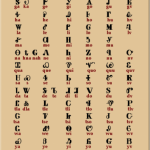Translating the Cherokee Language
By Sarah-Claire Jordan
 Cherokee is one of the most common Native American languages still spoken in the U.S. It is part of the Iroquoian language family, specifically the Southern Iroquoian branch. It is the only surviving language in that particular branch of Iroquoian, and is very healthy today thanks to the amount of documentation that has been done on the language. Though it is part of the family, Cherokee is very different from the other Iroquoian languages.
Cherokee is one of the most common Native American languages still spoken in the U.S. It is part of the Iroquoian language family, specifically the Southern Iroquoian branch. It is the only surviving language in that particular branch of Iroquoian, and is very healthy today thanks to the amount of documentation that has been done on the language. Though it is part of the family, Cherokee is very different from the other Iroquoian languages.
One thing that sets Cherokee apart from the other Iroquoian languages, like Seneca and Mohawk, is the writing system that was developed for it back in the 1820s. Sequoyah began experimenting with a way to write out the Cherokee language in the 1810s, and finalized the syllabary that would be the end product of this experimentation and development in the early 1820s. At first, he wanted to come up with one symbol for every word in Cherokee, but realized that would be far too difficult to learn and memorize. Next, he tried the same thing, but with ideas instead of words, but ran into the same problem. Finally, he realized the best way to create a writing system for Cherokee would be to create a syllabary, where each syllable used in the Cherokee language had its own symbol. He was able to convince other Cherokee to use it eventually, resulting in the development of the first newspaper for Native Americans written in an indigenous language.
Translating Cherokee can be a bit tricky. First of all, there are two dialects of Cherokee still used today, with slightly different writing systems. For instance, the Cherokee syllabary originally had 86 syllables, but nowadays the number of syllables is much larger. The Otali dialect spoken in Oklahoma uses 122 different syllables to write in Cherokee, for instance. The Otali dialect is also the one that has changed the most in terms of adopting words from other languages. The Giduwa dialect of the Eastern Band of the Cherokee has stayed a little more true to the version of it that was spoke at the time of Sequoyah’s development.
Something else that needs to be considered when translating Cherokee is the fact that the grammar can be quite complex. Around three quarters of Cherokee words are verbs, and all of the words are polysynthetic, meaning that any number of word parts can be added to a word to make an entire sentence sometimes, which will still be just one word. Some verbs even have to have a classifier, which are used to describe some physical trait an object has.
Cherokee is a very difficult language for native English speakers to learn, so translating from Cherokee into English is reserved for those who have studied extensively and have years and years of experience translating. Besides having to learn a whole new writing system, there can be little errors in terms of words that are one transliterated letter off once the syllables are transliterated into a Latin script. This is very important work, though, as translating Cherokee helps keep the language alive.
For an overview of our translation expertise, visit our telephone interpreting service page
Category: Foreign Language








